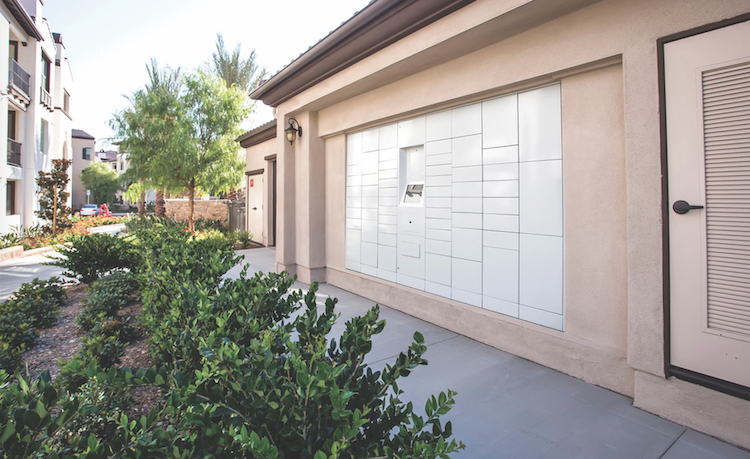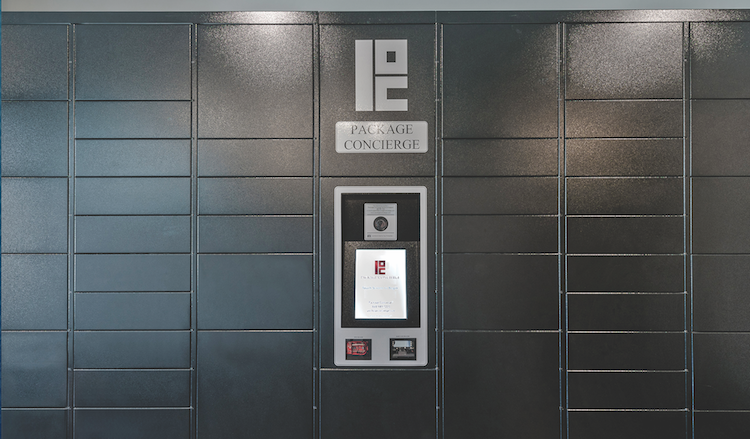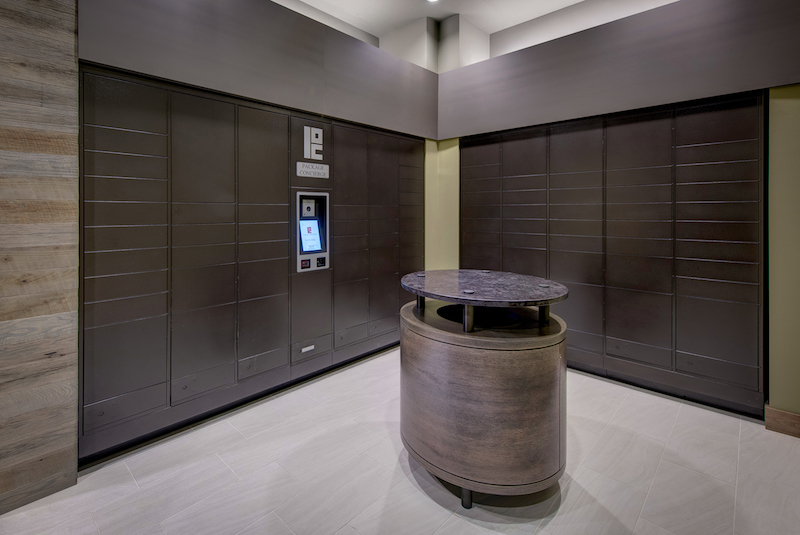Why did you refuse that?” George Costanza asks Jerry in a 1996 episode of “Seinfeld.” “Everybody loves a package.”
That might have been true back then, when Amazon was a mere online bookstore and receiving a package hadn’t become part of the daily routine. Today, anyone managing a decent-sized apartment or condo community may find the onslaught of packages overwhelming. With residents able to get delivery of anything from a pack of gum, to a $600 iPhone, to the refrigerated ingredients for that night’s dinner, multifamily complexes are awash in a swirling tide of cardboard boxes and plastic bags.
“The exponential growth of Amazon and other package delivery services has had a profound impact on the design of today’s multifamily communities,” says Rohit Anand, AIA, NCARB, Principal, KTGY Architecture + Planning. “Everything from groceries, to dry cleaning, to traditional online purchases is being delivered on a daily basis, leaving it up to property managers to determine how best to distribute them to residents.” In some cases, says Anand, residents expect around-the-clock access to their packages due to their busy schedules.
The solution: dedicated package delivery centers. Such facilities have been around for the last decade or so in some multifamily communities, but have grown in number and sophistication as the flood of packages has risen, and as residents’ reliance on them has gone up exponentially. Apartment managers and condominium associations also have to be concerned about legal liabilities associated with lost or damaged packages, and the mounting cost of staff hours devoted to accept and deliver packages.
DEFINING THE PACKAGE CENTER
A package center is a dedicated, secure space for delivered packages to be stored until residents can pick them up (or, in some cases, have them delivered directly to their units). Some centers take the form of a traditional mailroom, staffed with personnel to retrieve and manage packages for residents. But employing enough staff to allow residents 24/7 access to their packages can become difficult and expensive, so package delivery centers are automating.
Automated systems, such as those provided by Package Concierge or Parcel Pending, store packages in secure lockers. When a courier delivers a package, he/she will follow the integrated touchscreen’s prompts to enter the recipient’s name and select an appropriately sized locker. A locker will then open and the package can be placed inside.
Once the locker door is closed, a text message is sent automatically to the recipient alerting the person of the package’s arrival and providing a unique PIN. To get the package, the resident need only enter the PIN and the locker door will automatically open. Residents can access their packages any time, day or night.
 The Palisades at Sierra del Oro, Corona, Calif., developed by MBK Rental Living, uses an automated center to give residents 24/7 access to deliveries. Photo: MBK Rental Living
The Palisades at Sierra del Oro, Corona, Calif., developed by MBK Rental Living, uses an automated center to give residents 24/7 access to deliveries. Photo: MBK Rental Living
Due to the ever-increasing volume of deliveries, package centers are getting bigger and bigger. “Prior to the recession, we would allocate about one square foot of wall area per unit when designing a package room,” says Anand. “We later doubled that number to two square feet, and now are finding that we need to set aside three square feet per unit in some of the newest residential communities.”
Kass Management offers a service called Doorman, where packages are collected at an off-site location until residents can arrange for pickup. “We wanted a solution that addressed the need, yet was still economical,” says Kass’s Mark Durakovic, Principal.
Steven Fifield, President of Fifield Companies, says his company is even coordinating deliveries of “lifestyle-service” providers—Pilates instructors, dog groomers, personal chefs—who perform in-home services for apartment and condo dwellers.
Then there’s the proliferation of food-delivery services like Peapod and Blue Apron. To keep food from spoiling, package centers are starting to incorporate refrigerated rooms or lockers. RMK Management Corp. is retrofitting some properties with coolers and installing refrigeration rooms in new developments. “Refrigeration was virtually nonexistent before the recession,” Anand says. “Today, it is offered in approximately 10% of new residential communities.”
IT’S A COMMUNITY AFFAIR
Many rental and condominium communities integrate package centers into high-traffic areas. Not only does this make it easier for couriers to find the center and deliver packages, it also makes receiving a package a neighborly event.
If planned and designed appropriately, package centers can strengthen community ties among residents. The inclusion of communal tables and recycling bins gives residents the option to open their packages immediately while socializing with their neighbors. “Ultimately, it’s about the resident experience,” says Anand. “As designers, how can we create a community where serendipitous encounters lead to long-lasting relationships among residents?”
What about drone deliveries? Now that Amazon Prime Air and others are toying with the idea, figuring how best to integrate drone deliveries with package centers may prove to be a bit of a head-scratcher for designers. “Drones and packaging centers will need to be compatible,” says Rick Fletcher, Vice President of Sales & Marketing, MBK Homes.
But large-scale package delivery via drones does not appear to be imminent. There are plenty of logistical and regulatory hurdles Amazon and its online siblings will have to overcome before the skies will be filled with the sonorous buzz of package-laden drones.
 With the Package Concierge touchscreen at Village Plaza, Chapel Hill, N.C., designed by KTGY Architecture, the tenant follows the touchscreen prompts, enters a PIN, and the correct locker automatically opens. Photo: courtesy KTGY Architecture
With the Package Concierge touchscreen at Village Plaza, Chapel Hill, N.C., designed by KTGY Architecture, the tenant follows the touchscreen prompts, enters a PIN, and the correct locker automatically opens. Photo: courtesy KTGY Architecture
Related Stories
| Jan 27, 2011
Perkins Eastman's report on senior housing signals a changing market
Top international design and architecture firm Perkins Eastman is pleased to announce that the Perkins Eastman Research Collaborative recently completed the “Design for Aging Review 10 Insights and Innovations: The State of Senior Housing” study for the American Institute of Architects (AIA). The results of the comprehensive study reflect the changing demands and emerging concepts that are re-shaping today’s senior living industry.
| Jan 21, 2011
Harlem facility combines social services with retail, office space
Harlem is one of the first neighborhoods in New York City to combine retail with assisted living. The six-story, 50,000-sf building provides assisted living for residents with disabilities and a nonprofit group offering services to minority groups, plus retail and office space.
| Jan 21, 2011
Nothing dinky about these residences for Golden Gophers
The Sydney Hall Student Apartments combines 125 student residences with 15,000 sf of retail space in the University of Minnesota’s historic Dinkytown neighborhood, in Minneapolis.
| Jan 21, 2011
Revamped hotel-turned-condominium building holds on to historic style
The historic 89,000-sf Hotel Stowell in Los Angeles was reincarnated as the El Dorado, a 65-unit loft condominium building with retail and restaurant space. Rockefeller Partners Architects, El Segundo, Calif., aimed to preserve the building’s Gothic-Art Nouveau combination style while updating it for modern living.
| Jan 21, 2011
Upscale apartments offer residents a twist on modern history
The Goodwynn at Town: Brookhaven, a 433,300-sf residential and retail building in DeKalb County, Ga., combines a historic look with modern amenities. Atlanta-based project architect Niles Bolton Associates used contemporary materials in historic patterns and colors on the exterior, while concealing a six-level parking structure on the interior.
| Jan 20, 2011
Worship center design offers warm and welcoming atmosphere
The Worship Place Studio of local firm Ziegler Cooper Architects designed a new 46,000-sf church complex for the Pare de Sufrir parish in Houston.
| Jan 19, 2011
Baltimore mixed-use development combines working, living, and shopping
The Shoppes at McHenry Row, a $117 million mixed-use complex developed by 28 Walker Associates for downtown Baltimore, will include 65,000 sf of office space, 250 apartments, and two parking garages. The 48,000 sf of main street retail space currently is 65% occupied, with space for small shops and a restaurant remaining.
| Jan 7, 2011
Mixed-Use on Steroids
Mixed-use development has been one of the few bright spots in real estate in the last few years. Successful mixed-use projects are almost always located in dense urban or suburban areas, usually close to public transportation. It’s a sign of the times that the residential component tends to be rental rather than for-sale.
| Jan 4, 2011
An official bargain, White House loses $79 million in property value
One of the most famous office buildings in the world—and the official the residence of the President of the United States—is now worth only $251.6 million. At the top of the housing boom, the 132-room complex was valued at $331.5 million (still sounds like a bargain), according to Zillow, the online real estate marketplace. That reflects a decline in property value of about 24%.















